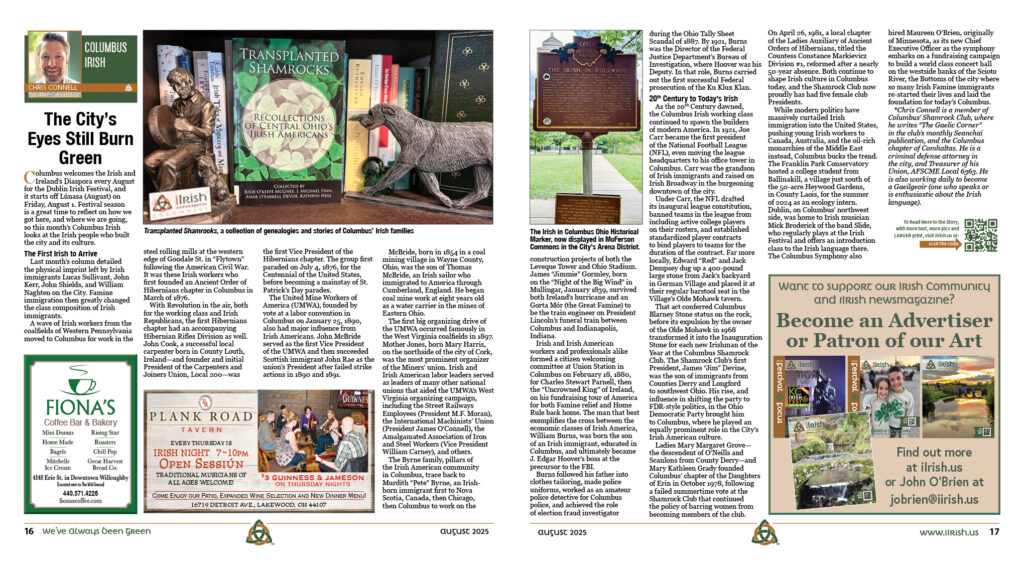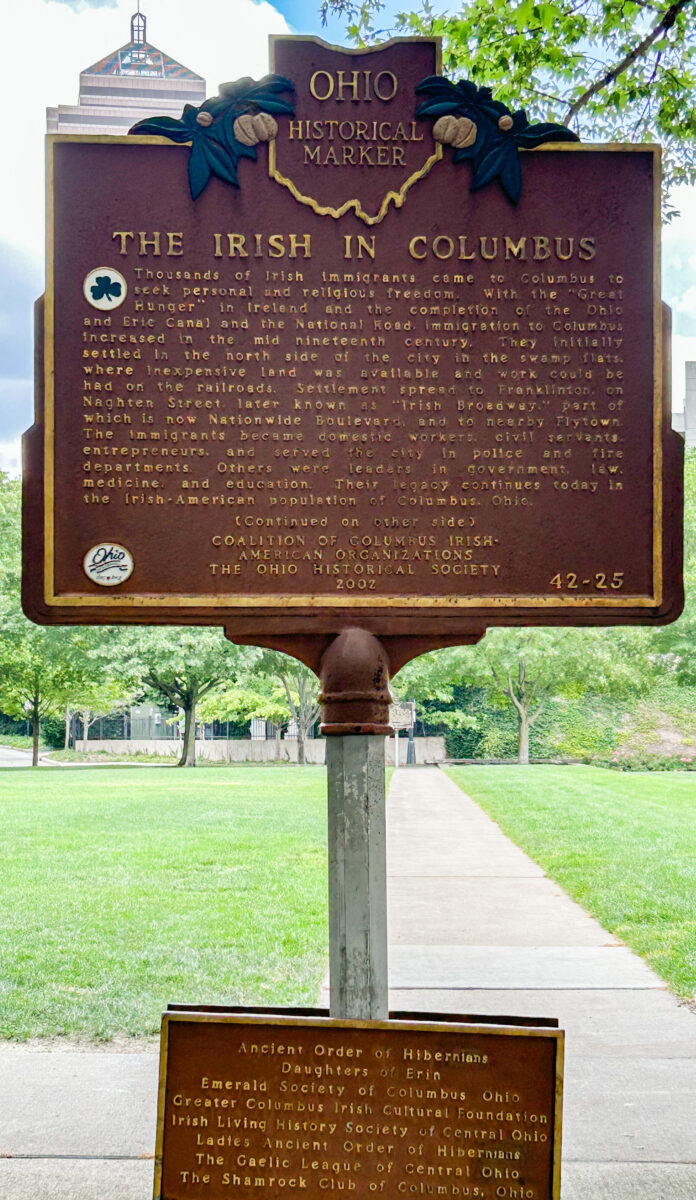
The City’s Eyes Still Burn Green
Columbus welcomes the Irish and Ireland’s Diaspora every August for the Dublin Irish Festival, and it starts off Lúnasa (August) on Friday, August 1. Festival season is a great time to reflect on how we got here, and where we are going, so this month’s Columbus Irish looks at the Irish people who built the city and its culture.

The First Irish to Arrive
Last month’s column detailed the physical imprint left by Irish immigrants Lucas Sullivant, John Kerr, John Shields, and William Naghten on the City. Famine immigration then greatly changed the class composition of Irish immigrants.
A wave of Irish workers from the coalfields of Western Pennsylvania moved to Columbus for work in the steel rolling mills at the western edge of Goodale St. in “Flytown” following the American Civil War. It was these Irish workers who first founded an Ancient Order of Hibernians chapter in Columbus in March of 1876.
With Revolution in the air, both for the working class and Irish Republicans, the first Hibernians chapter had an accompanying Hibernian Rifles Division as well. John Cook, a successful local carpenter born in County Louth, Ireland—and founder and initial President of the Carpenters and Joiners Union, Local 200—was the first Vice President of the Hibernians chapter. The group first paraded on July 4, 1876, for the Centennial of the United States, before becoming a mainstay of St. Patrick’s Day parades.

The United Mine Workers of America (UMWA), founded by vote at a labor convention in Columbus on January 25, 1890, also had major influence from Irish Americans. John McBride served as the first Vice President of the UMWA and then succeeded Scottish immigrant John Rae as the union’s President after failed strike actions in 1890 and 1891.
McBride, born in 1854 in a coal mining village in Wayne County, Ohio, was the son of Thomas McBride, an Irish sailor who immigrated to America through Cumberland, England. He began coal mine work at eight years old as a water carrier in the mines of Eastern Ohio.
The first big organizing drive of the UMWA occurred famously in the West Virginia coalfields in 1897. Mother Jones, born Mary Harris, on the northside of the city of Cork, was the most prominent organizer of the Miners’ union. Irish and Irish American labor leaders served as leaders of many other national unions that aided the UMWA’s West Virginia organizing campaign, including the Street Railways Employees (President M.F. Moran), the International Machinists’ Union (President James O’Connell), the Amalgamated Association of Iron and Steel Workers (Vice President William Carney), and others.
The Byrne family, pillars of the Irish American community in Columbus, trace back to Murdith “Pete” Byrne, an Irish-born immigrant first to Nova Scotia, Canada, then Chicago, then Columbus to work on the construction projects of both the Leveque Tower and Ohio Stadium. James “Jimmie” Gormley, born on the “Night of the Big Wind” in Mullingar, January 1839, survived both Ireland’s hurricane and an Gorta Mór (the Great Famine) to be the train engineer on President Lincoln’s funeral train between Columbus and Indianapolis, Indiana.
Irish and Irish American workers and professionals alike formed a citizen welcoming committee at Union Station in Columbus on February 18, 1880, for Charles Stewart Parnell, then the “Uncrowned King” of Ireland, on his fundraising tour of America for both Famine relief and Home Rule back home. The man that best exemplifies the cross between the economic classes of Irish America, William Burns, was born the son of an Irish immigrant, educated in Columbus, and ultimately became J. Edgar Hoover’s boss at the precursor to the FBI.
Burns followed his father into clothes tailoring, made police uniforms, worked as an amateur police detective for Columbus police, and achieved the role of election fraud investigator during the Ohio Tally Sheet Scandal of 1887. By 1921, Burns was the Director of the Federal Justice Department’s Bureau of Investigation, where Hoover was his Deputy. In that role, Burns carried out the first successful Federal prosecution of the Ku Klux Klan.
20th Century to Today’s Irish
of modern America. In 1921, Joe Carr became the first president of the National Football League (NFL), even moving the league headquarters to his office tower in Columbus. Carr was the grandson of Irish immigrants and raised on Irish Broadway in the burgeoning downtown of the city.
Under Carr, the NFL drafted its inaugural league constitution, banned teams in the league from including active college players on their rosters, and established standardized player contracts to bind players to teams for the duration of the contract. Far more locally, Edward “Red” and Jack Dempsey dug up a 400-pound large stone from Jack’s backyard in German Village and placed it at their regular barstool seat in the Village’s Olde Mohawk tavern.
That act conferred Columbus Blarney Stone status on the rock, before its expulsion by the owner of the Olde Mohawk in 1968 transformed it into the Inauguration Stone for each new Irishman of the Year at the Columbus Shamrock Club. The Shamrock Club’s first President, James “Jim” Devine, was the son of immigrants from Counties Derry and Longford to southwest Ohio. His rise, and influence in shifting the party to FDR-style politics, in the Ohio Democratic Party brought him to Columbus, where he played an equally prominent role in the City’s Irish American culture.
Ladies Mary Margaret Grove—the descendent of O’Neills and Scanlons from County Derry—and Mary Kathleen Grady founded Columbus’ chapter of the Daughters of Erin in October 1978, following a failed summertime vote at the Shamrock Club that continued the policy of barring women from becoming members of the club. On April 26, 1981, a local chapter of the Ladies Auxiliary of Ancient Orders of Hibernians, titled the Countess Constance Markievicz Division #1, reformed after a nearly 50-year absence. Both continue to shape Irish culture in Columbus today, and the Shamrock Club now proudly has had five female club Presidents.
While modern politics have massively curtailed Irish immigration into the United States, pushing young Irish workers to Canada, Australia, and the oil-rich monarchies of the Middle East instead, Columbus bucks the trend. The Franklin Park Conservatory hosted a college student from Ballinakill, a village just south of the 50-acre Heywood Gardens, in County Laois, for the summer of 2024 as an ecology intern. Dublin, on Columbus’ northwest side, was home to Irish musician Mick Broderick of the band Slide, who regularly plays at the Irish Festival and offers an introduction class to the Irish language there. The Columbus Symphony also hired Maureen O’Brien, originally of Minnesota, as its new Chief Executive Officer as the symphony embarks on a fundraising campaign to build a world class concert hall on the westside banks of the Scioto River, the Bottoms of the city where so many Irish Famine immigrants re-started their lives and laid the foundation for today’s Columbus.




